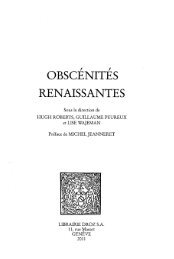Download (3398Kb) - ePrints Soton - University of Southampton
Download (3398Kb) - ePrints Soton - University of Southampton
Download (3398Kb) - ePrints Soton - University of Southampton
Create successful ePaper yourself
Turn your PDF publications into a flip-book with our unique Google optimized e-Paper software.
4.1.2- Body Size<br />
The reproductive output (the amount <strong>of</strong> gametes produced), the reproductive<br />
index (the amount <strong>of</strong> gametes produced per unit body weight), and the reproductive<br />
effort (the amount <strong>of</strong> gametes produced per total amount <strong>of</strong> production) are all<br />
important features <strong>of</strong> the reproductive cycle <strong>of</strong> the species. The interspecific variation<br />
in body size results in interspecific variation in reproductive output and reproductive<br />
index.<br />
Within a species, the relation between size and reproductive output is more<br />
direct. A certain minimal size <strong>of</strong> the body is required before an individual becomes<br />
reproductive. This may possibly be the body size that is necessary for the individual to<br />
be sufficiently functional in terms <strong>of</strong> feeding to support gonadal growth. The<br />
attainment <strong>of</strong> adult size occurs rapidly and results from allocating most <strong>of</strong> the<br />
acquired resources to growth rather than to reproduction. The trend seems to be to<br />
provide for an ever-increasing reproductive capacity until the adult size is reached.<br />
A major pattern <strong>of</strong> echinoderms involves their ability to cease growth when<br />
extrinsic food limitation exists. For example, Asterias rubens can stay as small<br />
individuals for months in a “waiting stage” before resuming a growth phase that<br />
eventually leads to a size at which reproduction may occur (Nauen, 1978). Some<br />
populations <strong>of</strong> Echinocardium cordatum may persist for even years as small<br />
individuals without ever becoming reproductive, apparently as a consequence <strong>of</strong> a low<br />
acquisition <strong>of</strong> nutrients (Buchanan, 1967)<br />
When extrinsic food limitation is less extreme, diverse species <strong>of</strong> echinoids,<br />
asteroids and holothurians do not reach their potential growth rate or maximum size<br />
but do reproduce (Lawrence and Lane, 1982). In this situation gonadal and somatic<br />
growth seem to have an opposite seasonal relationship. The apparent strategy here is<br />
78
















